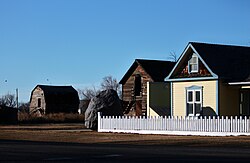Stirling Agricultural Village
| Stirling Agricultural Village | |
|---|---|

Replica pioneer home and Bishop's Storehouse to the left
|
|
| Type | Settlement |
| Etymology | John A. Stirling |
| Location | Village of Stirling, Alberta, Canada |
| Area | 2.64 km2 (1.02 sq mi) |
| Elevation | 935 m (3,068 ft) |
| Established | 1899 |
| Founder | -Theodore Brandley -LDS Church |
| Built | 1899 |
| Architect | Theodore Brandley |
| Architectural style(s) | -Plat of Zion -Victorian |
| Governing body | Stirling - Village Council |
| Important events | Stirling Settler Days |
| Website | Village of Stirling |
| Designated | 1997 |
Stirling Agricultural Village is a National Historic Site of Canada, and was listed as one of only three communities in Canada designated as a National Historic Site because of the community’s well preserved settlement pattern that follows the Plat of Zion model. The Michelsen Farmstead was the focus of the community, and is now a totally restored museum, listed as a Provincial Historic Site in 2001. The Galt Historic Railway Park is another popular museum located in this historic site.
Stirling was founded on May 5, 1899 by Theodore Brandley. The village was one of two communities that owed its existence to a partnership between The Church of Jesus Christ of Latter-day Saints and Charles A. Magrath of the North Western Coal and Navigation Company, and is one of only three communities designated as a National Historic Site of Canada. Stirling was named after John A. Stirling, Managing Director of The Trusts, Executors and Securities Corporation of London, which owned shares in the Alberta Coal and Railway Company.
After arriving at the Stirling siding, Theodore Brandley quickly started planning the lay-out of the village. The townsite was made up of one square mile (640 acres), then divided into lots of 10 acres (40,000 m2); each with a surveyed road around the entire area with a lane running north and south, dividing it into two parcels. The parcels were then again divided, east and west, making four lots, each 2.5 acres (10,000 m2), giving the residents room to build homes, barns and shelters for animals, with large gardens. Theodore planned the townsite after the Plat of Zion, which Stirling still follows today, and is recognized as the most well-preserved, Canadian example of the Plat of Zion. For this reason, Stirling is known as Stirling Agricultural Village
...
Wikipedia
